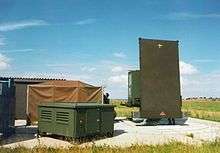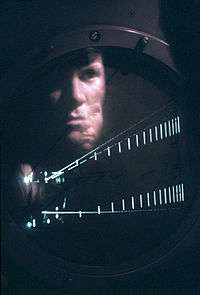Precision approach radar

Precision approach radar (PAR) is a type of radar guidance system designed to provide lateral and vertical guidance to an aircraft pilot for landing, until the landing threshold is reached. After the aircraft reaches the decision height (DH) or decision altitude (DA), guidance is advisory only. Controllers monitoring the PAR displays observe each aircraft's position and issue instructions to the pilot that keep the aircraft on course and glidepath during final approach. It is similar to an instrument landing system (ILS) but requires control instructions. One type of instrument approach that can make use of PAR is the ground-controlled approach (GCA). Air traffic controllers must transmit a minimum of every 5 seconds to the pilot their relation to the azimuth portion and, once intercepting the glidepath, their elevation. The approach is terminated when the aircraft reaches the OCA/H (Obstacle Clearance Altitude/Height). Nevertheless, information is provided till threshold and aircraft may be monitored by controller till touchdown. Controller in charge of PAR should not be responsible for any duty other than the PAR approach concerned.
The upper portion of the display indicates elevation, the lower portion azimuth. Controllers must be able to interpret radar returns for the azimuth as a "top view" to inform them if the aircraft is left or right of course.

Precision approach radars are most frequently used at military air traffic control facilities. Many of these facilities use the AN/FPN-63, AN/MPN, or AN/TPN-22. These radars can provide precision guidance to a distance of 10 to 20 miles. The OJ-333 Radar scope is the indicator which the air traffic controller uses to provide instructions to the pilots.
In the United States PAR are used mostly by The Navy. This is because they present a more covert type of precision approach for use on Aircraft carriers. An ILS installed on a ship could provide guidance to enemy missiles but a PAR does not provide accurate guidance without controller instruction.
Non-traditional PAR using SSR transponder reply
There are systems that provide PAR functionality without using primary radar. These non-traditional PAR systems use transponder multilateration, triangulation and/or trilateration.
One such system, Transponder Landing System (TLS) precisely tracks aircraft using the mode 3/A transponder response received by antenna arrays located near the runway. These antennas are part of a measurement subsystem that is used to precisely determine the aircraft 3-dimensional position using TOA, DTOA and AOA measurement techniques. The aircraft position is then displayed on a high-resolution color graphics terminal that also shows the approach centerline and the glide path. A GCA controller is then able to use this screen for reference to issue GCA instructions to the pilot.
The signal strength for the secondary surveillance radar subsystem of a non-traditional PAR is not attenuated by rain since the frequency is within the long range band, L-band. Therefore, a non-traditional PAR does not experience noticeable rain fade and in the case of the TLS has an operational range of 60 nm.
This system is co-operative depending, it means that in the case of transponder failure no aircraft detection will be provided.
Flight inspection of the PAR
A traditional PAR flight inspection procedure is performed without a navigation signal available to compare directly to a truth reference. A traditional PAR is flight inspected by comparing written notes between two observers, one taking notes at a truth reference system such as a theodolite and the other observer taking notes while observing the radar console, see ICAO Document 8071. The Transponder Landing System (TLS) non-traditional PAR can transmit an ILS signal that corresponds to the aircraft position relative to the precision approach. Therefore, the graphical depiction can be directly verified using Instrument Landing System (ILS) flight inspection techniques. This direct measurement removes some ambiguity from the PAR flight inspection process.
See also
- Acronyms and abbreviations in avionics
- Instrument approach
- TLS - Transponder Landing System
- Ground-controlled approach
- AN/MPN
- Electronics Technician